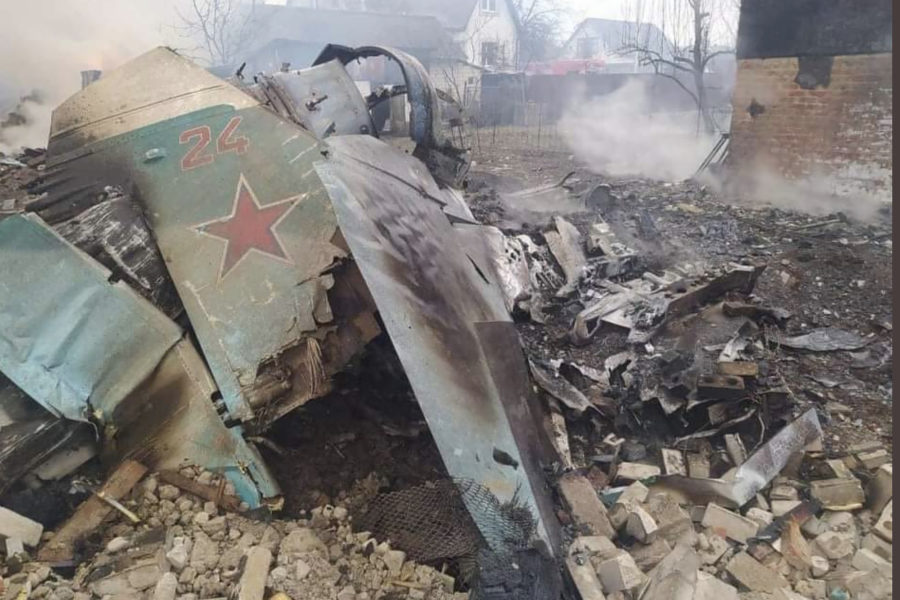The air war is changing over Ukraine, with Russia picking up the pace of sorties but running low on precision-guided munitions, a senior defense official said March 21. Russia also has allegedly fired hypersonic weapons, a move possibly made to gain momentum after nearly a month of fighting and no major population centers under its control.
“They are beginning to face some inventory issues with precision-guided munitions,” a senior defense official told reporters on a telephone briefing, explaining the increased use by Russia of unguided bombs, or “dumb bombs.”
The official also said Russia is seeing increased fail rates of its PGMs.
“They’re just not operating. They’re failing. Either they’re failing to launch, or they’re failing to hit the target, or they’re failing to explode on contact,” the official added. “Why would you need a hypersonic missile fired from not that far away to hit a building?”
Pentagon officials have not confirmed Russian claims that it used hypersonic weapons March 19 and March 20 to hit an ammunition depot in the Carpathian Mountains of Southwestern Ukraine and a fuel depot in Kostiantynivka, in Donetsk oblast. The second strike was just beyond the contact line of territory that Russian-backed forces have controlled since 2014. Both strikes are believed to have been fired from aircraft operating from Russian airspace.
“It could be that they’re running low on precision-guided munitions and feel like they need to tap into that resource,” the official said. “It could be that they’re trying to send a message to the West, but also to Ukraine, and trying to gain some leverage at the negotiating table.”
Securing Air Defenses
In a televised interview with CNN’s Fareed Zakaria on March 20, Ukrainian President Volodymyr Zelensky said he was willing to sit down one on one at the negotiating table with Russian President Vladimir Putin. Earlier in the week, Zelensky asked the American Congress for help obtaining the S-300 missile defense systems possessed by numerous Eastern European countries.
DOD has repeatedly said it is working to facilitate a transfer that would help Ukraine to better protect its skies. While visiting Slovakia on March 17, Defense Secretary Lloyd J. Austin III secured a willingness to transfer an S-300, but the following day Bulgaria’s prime minister emphatically refused to transfer its S-300 systems, or any lethal defense assistance, to Ukraine.
“These are active consultations,” Pentagon Press Secretary John F. Kirby said in a March 21 press briefing, “not only with that nation but many others about how to provide Ukraine the kinds of defensive capabilities, to include long-range air defense, that we know that they’re comfortable using, they’re trained on, that they already have in their inventory and whether that can be bolstered,” he explained.
Once secured, an S-300 could be in place in Ukraine within a week. The Wall Street Journal reported that Ukraine already operates some Russian air defense systems, such as the S-300, but is in need of more “to blunt Russia’s aircraft and missile attacks.”
Austin plans to accompany President Joe Biden to a NATO leaders summit in Brussels on March 24, followed by meetings in Poland on March 25.
As DOD works to get Ukraine more air defense systems, the Pentagon has said it will not stand in the way of unilateral combat aircraft transfers. On March 8, the U.S. refused a deal to take possession of Polish MiG-29s for onward transfer to Ukraine.
Meanwhile, Russia is stepping up its sorties.
“In the last 24-48 hours, we have seen air activity from both sides increase,” the senior defense official said.
The Pentagon assesses that Russia flew more than 300 sorties, but DOD declined to quantify the increase on the Ukrainian side. Ukraine had been flying as few as five to 10 daily sorties into contested airspace covered in large part by Russian surface-to-air missile systems.
After suffering more than 1,100 missile strikes, and with no NATO appetite for imposing a no-fly zone, Ukraine has increased its call for air defenses.
Russia may be attempting to strike more from the air before such systems are in place.
Russian ground forces are stalled outside Kyiv, Kharkiv, and Mariupol, the Sea of Azov port city that would help Russia form a land bridge from the Donbas region to Crimea. On March 21, Ukraine dismissed a Russian proposal to surrender Mariupol.
Thus far, Russia has taken control of just three cities, all in the south near heavily fortified Crimea. They are Kherson, Berdiansk, and Melitopol.
Russia is suffering setbacks in other tactical areas, the senior defense official said, from communications and command-and-control to logistical, sustainment, and surface-to-air integration.
“They are taking casualties every day,” the defense official said. “They are losing aircraft. They are losing armor and vehicles—there’s no doubt about that—tanks, [armored personnel carriers] APCs, artillery units, helicopters, fixed wing jets.”
The Pentagon assesses that Russia still retains just under 90 percent of its combat power. Likewise, Ukraine retains more than 90 percent of its own combat power thanks to constant replenishment from Western partners.
DOD expects a $300 million defense assistance package to run out by week’s end, but it is already sourcing an additional $800 million defense assistance package, the White House announced March 16.
“What we’re seeing is a near desperate attempt by the Russians to gain some momentum and try to turn the course of this in their favor,” the official said. “Right now, it doesn’t appear like they have a lot of leverage to negotiate with.”
